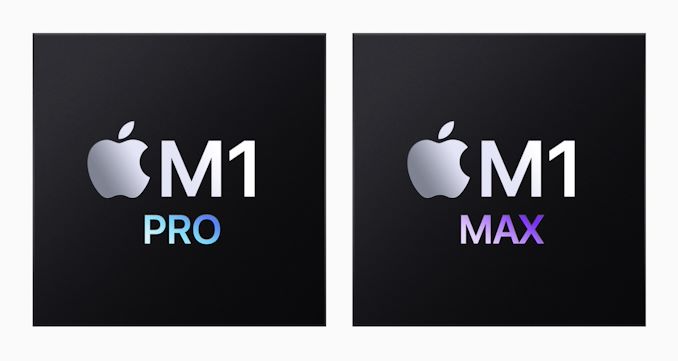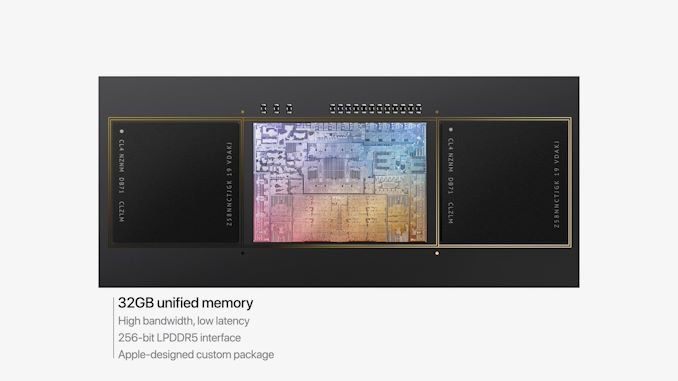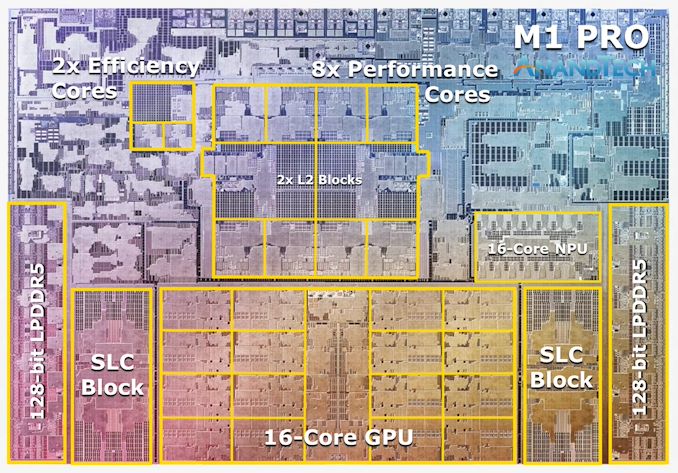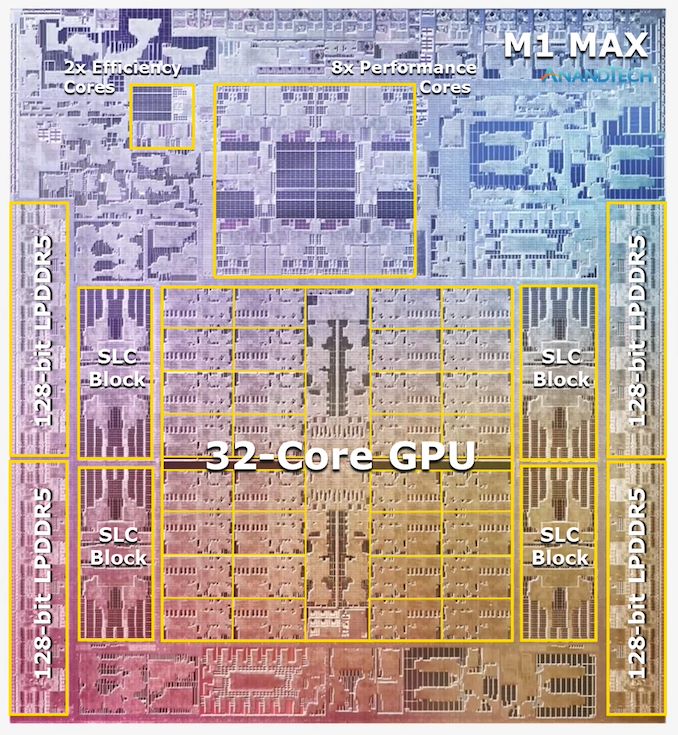Apple's M1 Pro, M1 Max SoCs Investigated: New Performance and Efficiency Heights
by Andrei Frumusanu on October 25, 2021 9:00 AM EST- Posted in
- Laptops
- Apple
- MacBook
- Apple M1 Pro
- Apple M1 Max

Last week, Apple had unveiled their new generation MacBook Pro laptop series, a new range of flagship devices that bring with them significant updates to the company’s professional and power-user oriented user-base. The new devices particularly differentiate themselves in that they’re now powered by two new additional entries in Apple’s own silicon line-up, the M1 Pro and the M1 Max. We’ve covered the initial reveal in last week’s overview article of the two new chips, and today we’re getting the first glimpses of the performance we’re expected to see off the new silicon.
The M1 Pro: 10-core CPU, 16-core GPU, 33.7bn Transistors
Starting off with the M1 Pro, the smaller sibling of the two, the design appears to be a new implementation of the first generation M1 chip, but this time designed from the ground up to scale up larger and to more performance. The M1 Pro in our view is the more interesting of the two designs, as it offers mostly everything that power users will deem generationally important in terms of upgrades.
At the heart of the SoC we find a new 10-core CPU setup, in a 8+2 configuration, with there being 8 performance Firestorm cores and 2 efficiency Icestorm cores. We had indicated in our initial coverage that it appears that Apple’s new M1 Pro and Max chips is using a similar, if not the same generation CPU IP as on the M1, rather than updating things to the newer generation cores that are being used in the A15. We seemingly can confirm this, as we’re seeing no apparent changes in the cores compared to what we’ve discovered on the M1 chips.
The CPU cores clock up to 3228MHz peak, however vary in frequency depending on how many cores are active within a cluster, clocking down to 3132 at 2, and 3036 MHz at 3 and 4 cores active. I say “per cluster”, because the 8 performance cores in the M1 Pro and M1 Max are indeed consisting of two 4-core clusters, both with their own 12MB L2 caches, and each being able to clock their CPUs independently from each other, so it’s actually possible to have four active cores in one cluster at 3036MHz and one active core in the other cluster running at 3.23GHz.
The two E-cores in the system clock at up to 2064MHz, and as opposed to the M1, there’s only two of them this time around, however, Apple still gives them their full 4MB of L2 cache, same as on the M1 and A-derivative chips.
One large feature of both chips is their much-increased memory bandwidth and interfaces – the M1 Pro features 256-bit LPDDR5 memory at 6400MT/s speeds, corresponding to 204GB/s bandwidth. This is significantly higher than the M1 at 68GB/s, and also generally higher than competitor laptop platforms which still rely on 128-bit interfaces.
We’ve been able to identify the “SLC”, or system level cache as we call it, to be falling in at 24MB for the M1 Pro, and 48MB on the M1 Max, a bit smaller than what we initially speculated, but makes sense given the SRAM die area – representing a 50% increase over the per-block SLC on the M1.
The M1 Max: A 32-Core GPU Monstrosity at 57bn Transistors
Above the M1 Pro we have Apple’s second new M1 chip, the M1 Max. The M1 Max is essentially identical to the M1 Pro in terms of architecture and in many of its functional blocks – but what sets the Max apart is that Apple has equipped it with much larger GPU and media encode/decode complexes. Overall, Apple has doubled the number of GPU cores and media blocks, giving the M1 Max virtually twice the GPU and media performance.
The GPU and memory interfaces of the chip are by far the most differentiated aspects of the chip, instead of a 16-core GPU, Apple doubles things up to a 32-core unit. On the M1 Max which we tested for today, the GPU is running at up to 1296MHz - quite fast for what we consider mobile IP, but still significantly slower than what we’ve seen from the conventional PC and console space where GPUs now can run up to around 2.5GHz.
Apple also doubles up on the memory interfaces, using a whopping 512-bit wide LPDDR5 memory subsystem – unheard of in an SoC and even rare amongst historical discrete GPU designs. This gives the chip a massive 408GB/s of bandwidth – how this bandwidth is accessible to the various IP blocks on the chip is one of the things we’ll be investigating today.
The memory controller caches are at 48MB in this chip, allowing for theoretically amplified memory bandwidth for various SoC blocks as well as reducing off-chip DRAM traffic, thus also reducing power and energy usage of the chip.
Apple’s die shot of the M1 Max was a bit weird initially in that we weren’t sure if it actually represents physical reality – especially on the bottom part of the chip we had noted that there appears to be a doubled up NPU – something Apple doesn’t officially disclose. A doubled up media engine makes sense as that’s part of the features of the chip, however until we can get a third-party die shot to confirm that this is indeed how the chip looks like, we’ll refrain from speculating further in this regard.














493 Comments
View All Comments
coolfactor - Tuesday, October 26, 2021 - link
That's not true. Yes, they have common roots, but they are definitely not the same OS line-for-line. Prior to M1, they were even compiled for different architectures. The OS is much more than a "skin". Many people wish that macOS and iOS were skinned, so they could customize that skin!darwinosx - Monday, October 25, 2021 - link
Apple does a lot of open source and contributes to the community.https://opensource.apple.com
Oxford Guy - Friday, October 29, 2021 - link
'They've eaten OpenGL problems for years and they've had enough, thus no respect for open-source.'My understanding is that Apple stuck with an extremely outdated version of OpenGL for years and years. Hard to claim that open source is the problem, since all the updates were ignored.
coolfactor - Tuesday, October 26, 2021 - link
@photovirus is correct. Metal achieves much better performance because Apple can design it to work on their hardware. Open-source solutions are good in principle and have their solid place in the software universe, but that doesn't mean it's the best solution in _every_ case. Metal solves a problem that plagued Macs for too long.varase - Wednesday, November 3, 2021 - link
Well, Apple can design it to work with any hardware it uses.That has in the past included AMD graphics cards.
Eric S - Saturday, October 30, 2021 - link
Not really. Metal makes sense for Apple. A graphics stack these days is a compiler. It is built on the LLVM project and C++ that they already use for their other compiler work. They will likely base it on their Swift compiler eventually. You can still use Vulcan on Mac and iOS since it’s shading language can be translated to Metal.Hifihedgehog - Monday, October 25, 2021 - link
> What isn't nice is gaming on macOSThat's a whole lot of damage control and pussyfooting around the truth. GFXBench is a joke for getting a pulse for real-world performance. In actuality, we are GPU bound at this point. Hence, the linear scaling from the M1 Pro to the M1 Max. The bottom line is this performs like an RTX 3060 in real-world games.
zshift - Monday, October 25, 2021 - link
As noted in the article, these benchmarks were run on x86 executables. The fact that it can keep up with 3060 levels of performance is incredible, but we can’t make any real judgements until we see how natively-compiled games run.sirmo - Monday, October 25, 2021 - link
@zshift 3060 uses a 192-bit memory bus, M1 Max has 512 bits and a huge GPU. Not to mention 6600xt does even better with less (only 128-bit memory bus). It's also only 11B transistors, while this SoC is 57B for perspective. It really isn't impressive tbh.Ppietra - Monday, October 25, 2021 - link
If they use different memory type it’s irrelevant to talk bit width.Furthermore it doesn’t make much sense as argument to compare a GPU number of transistors with a SoC number.